“People are like, ‘Wow! How has all this happened so fast?!’ And even to me it is kind of miraculous,” admits Anwar. “But it’s been a decade of massive ups and downs, pressures and doubts. For a long time, I was doing all these separate things – teaching meditation, making furniture, designing objects. But now that I’ve had a taste of sculpture, I’m like a dog with a bone – I’m just going to keep doing it.”
Born and raised in Sheffield’s Kelvin flats – a prime example of the blunt, high-rise architecture that shot up in 1960s cities – Brutalism is in Anwar’s blood. “My first memories are of playing on landings up in the sky. You’d kick the ball over the edge and it’d be like, ‘Who’s fetching it?!’,” he laughs. “But the design and experience have stayed with me: big concrete structures everywhere, stark lines, messing about in lift shafts.”
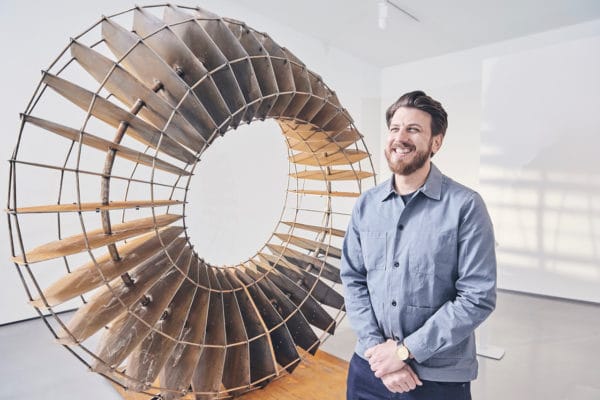
It wasn’t only the aesthetics of his early surroundings that piqued Anwar’s senses; the mighty foundries of the so-called ‘Steel City’ also formed an aural backdrop. “I used to walk the dog really early in the mornings and you’d always hear the foundries – that smashing of cold metal.”
This evocative recollection brings to mind George Orwell’s description of the “sinister magnificence” assumed by Sheffield’s factories during the peak of their industrial prowess:
“Through the open doors of foundries, you see fiery serpents of iron being hauled to and fro by redlit boys, and you hear the whizz and thump of steam hammers and the scream of the iron under the blow.”
The impact of Anwar’s formative exposure to the sights and sounds of factory life is clear to see in the sculptures he creates under his studio pseudonym, Sapien. Wrought from Corten Steel – also known as ‘weathering steel’ because of its pleasing propensity to rust and change colour – his work has an undeniably industrial quality. Both ‘Mantra Machine’ and ‘Only Breath’ conjure imagery of wheels, cogs, jet engines or propellers; spiralling onwards in continuous motion. And yet, for all their steely sturdiness and complex construction, there is a real sense of space, lightness and flow to Anwar’s sculptures. This duality is no coincidence, he says.
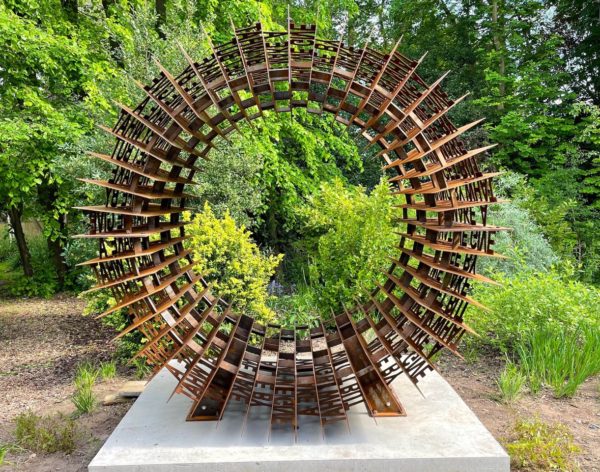
“Sapien is a collision of my industrial Sheffield roots with Eastern spiritual wisdom,” he explains. After an illness left him bedridden for five years, Anwar discovered meditation as a way of regaining health and focus. “I see meditation and art as one. I think creative ideas all come from that same space that you connect with when you meditate. I’ve hinted at it with some of my furniture, but I love the freedom of art, and how you’re not held back by functionality.”
Anwar meditates “every single day”, doing yoga, Qigong, breathing exercises and visualisation. Did he visualise that one day he’d find success as a sculptor? “It’s funny you should ask, because I’ve been doing visualisations for the last three years on having a sculpture at the Yorkshire Sculpture Park, and here we are!” he laughs.
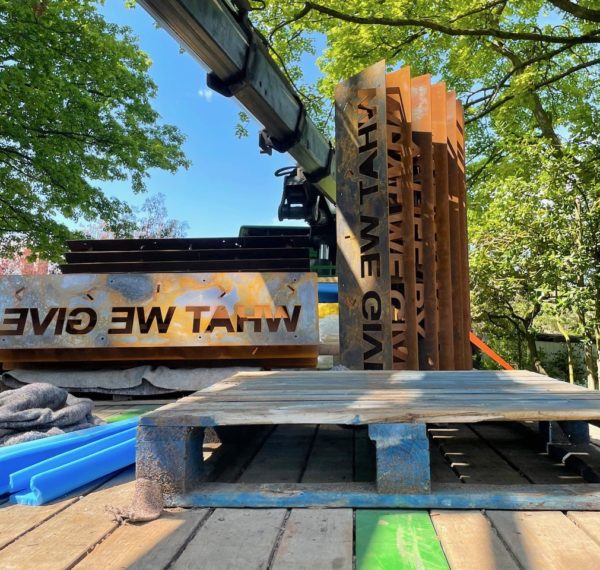
One of his favourite aspects of spiritual philosophy is Taoism, “where we talk about the yin and the yang,” he explains. “You can’t have one without the other. It’s the same with my art – that balance between two seemingly opposite themes.”
This opposition is showcased to striking effect in the piece which won Anwar the northern heat, and got him through to the grand finale, of Sky’s Landmark series – where 18 artists compete for the chance to make the UK’s next major public landmark. Titled ‘Only Breath’, Anwar’s abstract steel vortex was inspired by the act of breathing (a core pillar of meditation) and a poem of the same name by the famous Sufi poet, Rumi. Though welded from solid steel, it has a miraculous, almost organic, air of weightlessness and expansion; something that impressed the show’s judges.
“Sapien is a collision of my industrial Sheffield roots with Eastern spiritual wisdom. I see meditation and art as one – I think creative ideas all come from that same space that you connect with when you meditate.”
But Anwar’s triumphant television debut almost didn’t happen. “I saw the call out for Landmark with three days until the deadline,” he says. He needn’t have worried as, alongside fellow northern artists Sadie Clayton and Saad Qureshi, Anwar was selected to represent the region.
“I was scrambling to find a place to actually make the sculpture,” he recalls. “I’d visited derelict warehouses and buildings that looked the part – but they didn’t have a power supply, so I couldn’t use them. Then, a few days before we started filming, I discovered that the space at Peddler Market (a usually bustling street food and live music venue in Sheffield) was free because of Covid – so I hired it on the spot.”
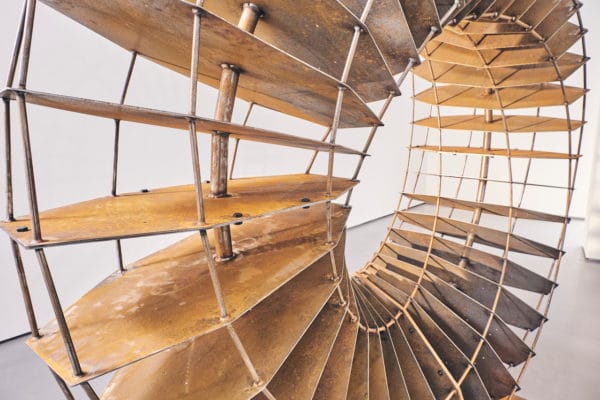
While the Landmark artists are the creators and designers of their concepts, producing sculptures on this scale is a team effort, involving skilled welders, fabricators and laser cutters. Before studying industrial design at university, Anwar had a stint manufacturing metal signage – “So I’m pretty good with the tools,” he says. “I just don’t have the capacity to weld like that. Plus, I love the spirit of collaboration and having banter with the factory guys.”
All final drawings also had to be ready before filming on Landmark could begin, “and they have to be super precise, because if the laser cutting is wrong, it throws the whole thing out,” he says.
Would he ever consider doing the welding himself on future sculptures? “Ultimately, I like variety and doing different things. And to become a detailed welder takes years and years. But I’m very hands-on; I always want to be in the factory while they’re making a piece to ensure the quality is there.”
For anyone wanting to catch a glimpse of ‘Only Breath’ in person, the sculpture is on a 12-month loan to Grizedale Forest in the Lake District. “After that, it may stay there, or perhaps come back to Sheffield, the city that inspired it,” he says. “We’ll have to wait and see.”
With ‘Only Breath’ influenced by poetry and ‘Mantra Machine’ giving physical form to words, Anwar’s work reveals a strong connection with language and storytelling. “Words are powerful. They’re like spells,” he says. “There’s this great quote by the Persian poet Hafiz: ‘The words you speak become the house you live in,’ which I think is bang-on. Our choice of words massively impacts the reality we experience. They help give meaning to thoughts and memories.”
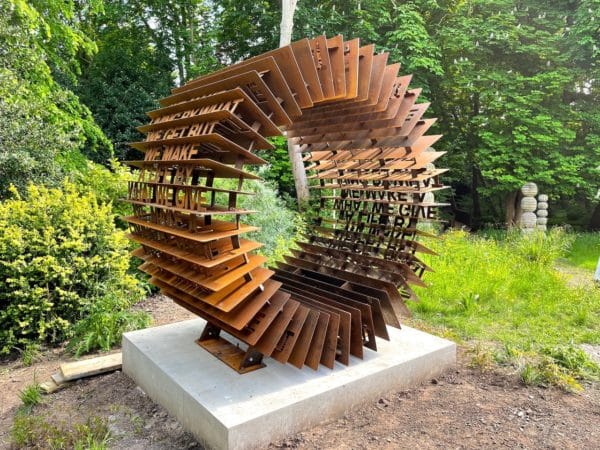
“Words are powerful. They’re like spells. There’s this great quote: ‘The words you speak become the house you live in,’ which I think is bang-on.”
Installed at the Yorkshire Sculpture Park to rust before being moved to the collector’s estate, Anwar’s ‘Mantra Machine’ pays homage to the mechanics of the mind. “It represents this idea of suspended consciousness, with the large void at the centre representing a state of oneness which can be achieved through deep meditation, and the non-stop activity of the mind endlessly rotating around the outside.”
The mantra in question here is a quote by Winston Churchill, in keeping with the collector’s philanthropic work: “You make a living by what you get; you make a life by what you give.” Repeated 12 times, the words become almost hypnotic. “Mantras are an ancient form of meditation,” Anwar explains. “When repeated, they take you from a state of busyness to a state of stillness and silence. Mantra is a Sanskrit term, ‘man’ means mind and ‘tra’ means vehicle or instrument, so your mantra becomes your mind vehicle.”
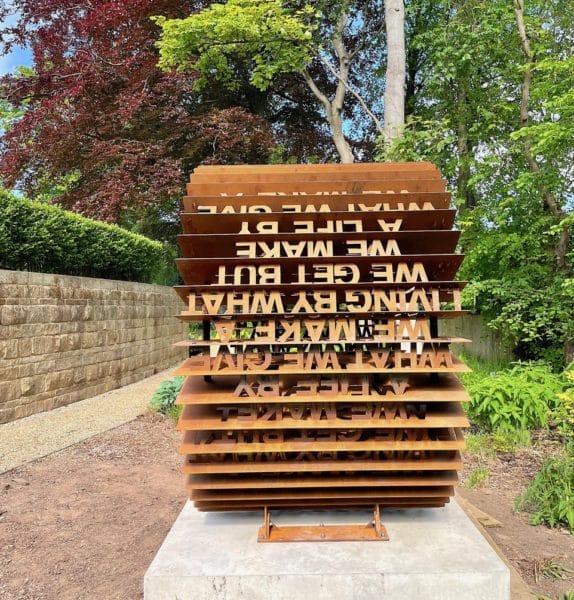
Sitting within a long tradition of verbal and visual interweaving – from Egyptian hieroglyphs and illuminated medieval manuscripts to 20th century advertising and word artists like Jenny Holzer – Anwar’s sculptures are testament to the power of art to amplify language. The letters in his ‘Mantra Machine’ feel simultaneously abstract and tangible: ethereal ideas allowed to cast shadows. Viewed from a distance, the structure bears a striking resemblance to the open pages of a book. “I’ve got plans for multiple mantra machines,” he smiles.
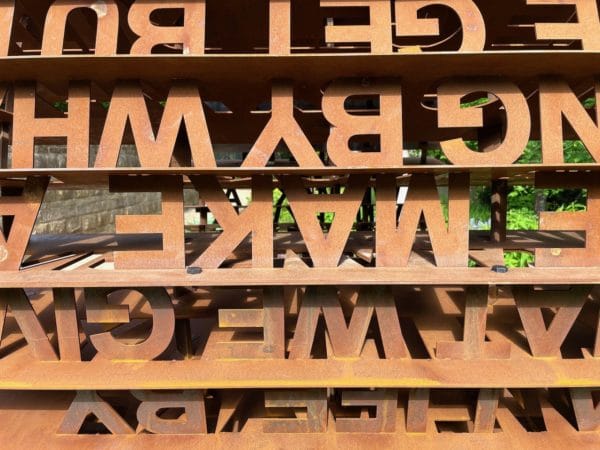
In everything he does, Anwar’s passion for authenticity shines through. “I just love raw, honest materials,” he enthuses. “Sustainability is important to me as well. Even though it takes a lot of energy to produce, steel can be melted down an endless amount of times without any loss of properties – you can recycle it on an infinite loop with no downgrading. But something I want to revisit in the future is looking at even more sustainable materials and using different types of wood. I’m constantly amazed by the beauty of trees – I’m not sure anything can be more sculptural than a tree.”
Staying true to his northern storyteller roots, Anwar is currently in the process of making two new sculptures for a site close to ‘The Battle of Orgreave’ – a brutally violent 1984 confrontation between striking miners and police at a British Steel Corporation coking plant in Rotherham. “They’ll be permanent landmark sculptures – vertical shafts, probably about four metres high,” he says. “They’re inspired by the mining heritage and tap into that history, but without being clichéd or depressing. The new Advanced Manufacturing Park is nearby, where they make propellers, so I wanted it to connect with that idea of forward thrust and give the sculptures an inspirational feel – paying respect to the past but also embracing the future.
“I want to be doing this forever. Art without walls – I just love it.”